
Music works as a great stress buster and good music has the power to change the mood and increase the level of concentration. Guitar is one such musical instrument which makes both, the listener as well as the player spellbound. A member of the string family, Electric Guitar is a recent addition to the list. Introduced around the 1930 period, the Electric Guitar continues to have an impact on popular music. The sound of a guitar needs to be heard above the sound of loud brass instrument being played in an orchestra. Hence, there was a need to invent an instrument that could amplify the sound and stand out in an ensemble. The Electric Guitar was invented to suit this requirement. Today, the instrument is played by both young and the old with equal zest and vigour. Prior to the invention of the Electric Guitar, several other forms of guitar were in use. But, the Electric Guitar is the most suited to the current modern scenario as it easily transforms the notes into significant forms through the elements of rhythm, harmony and melody.
The Electric Guitar is a recent invention and was added in the list of musical instruments around 1930–1932. Guitar comes in various forms such as acoustic, semi–acoustic, Arch top etc. The need was to experiment and invent a new instrument whose sound could stand out from amongst the other loud instruments in an ensemble. The invention of the Electric Guitar can be credited to the manufacturers as well as the ones who played guitar as a hobby. It was first designed in 1931 by George Beauchamp of National Guitar Corporation along with Paul Barth. ‘Frying pan’ instrument of a single piece cast was invented by Harry Watson of National Guitar Corporation. Finally, the commercial production of Electric Guitars started around 1932, by the joint venture of George Beauchamp, Paul Barth and Adolph Rickenbacker. In 1945, Richard D Bourgerie made an Electric Guitar with pickups and amplifiers.
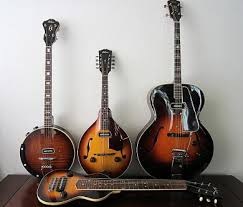
An Electric Guitar has three important components which are responsible for producing sound. They are pickups, amplifier and speaker. The magnetic pieces wired and mounted on the pick board between the bottom of the fret board and the bridge are called the ‘pickups’. The pickups pick up vibrations of the strings when the strings are struck. Beneath each pickup configuration, there is an individual magnet whereas in some Electric Guitars, there is a single magnetic strip running beneath the six strings attached to the pickups. Magnetic fields are produced by these electro–magnets. When the strings of the guitar are struck, they vibrate and these ‘vibrations’ or notes are reflected on the magnetic fields. The notes or vibrations are then converted into electrical sound signals, which are sent to an amplifier and then the sound is produced.
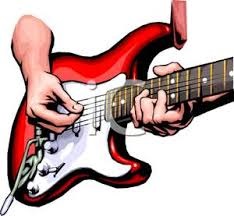
The components of an Electric Guitar are the wooden body, bridge, neck, tuners, headstock, nuts, frets, fingerboard, fret markers, pick guard, pickup, pickup selector, volume and tone controls, output jack and the strap pin.
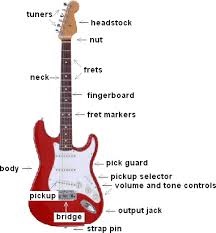
The body of the guitar is made from wood. It is carved out from wood and is based on the design of the particular model, either by hand or machinated. The neck is built to fit the body and shape of the contact area. The neck may be in a single piece or multiple pieces of wood joined together. Sometimes, a truss rod is placed in the neck for better adjustments. Some of the neck designs do not require the truss rod. The fret board is glued to the neck. The frets are placed at intervals which are decided by the scale of the guitar. The scale is the distance between the guitar nut and the bridge. All the electronic parts such as the pickups and controls are wired and are mounted on to the pick guard. The electrical parts are at times, mounted directly depending on the design of the instrument. All these parts are assembled, painted and glued and the guitar is tested for performance.
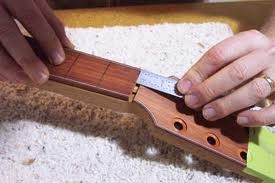
A guitar is the most favourite musical instrument of popular music and is well loved by all. Guitars are an essential part of the rhythmic section. Pop music, rock, hard rock, heavy metal, jazz and jazz fusion all incorporate the Electric Guitar for melody and solo rendition between the compositions. The Electric Guitar has been introduced in the classical music to an unexposed realm of music. It surpasses the acoustic ones in popular music due to its modern make and appeal.
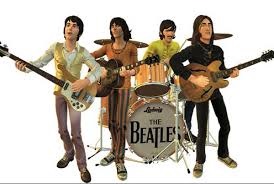
Some of the important types of Electric Guitar include:
- Solid Body: Such guitars come with wide variety of tones, deep volume and are very popular. For effective music, the body is made of a combination of woods such as maple, mahogany, alder and spruce and its neck may be made of rosewood. It is an ideal type of guitar for beginners.
- Hollow body: They are hollow on the inside but are fitted with many types of pickups such as hum bucker, single–coil, piezoelectric and so on. The hollow body guitar can compete with the loud brass instruments in the big bands.
- Semi–hollow body: More of a hybrid model, the semi–hollow body guitars have a block of wood running through the entire body. They produce a sweet, mellow chime–like tone with an acoustic resonance and are ideal for folk music, lead and soft country music.
- Electric acoustic: These types of guitars clearly resemble the acoustic guitars. They are fitted with pickups with no amplifier but can be played like the Electric Guitar.
- Strings, Neck and bridge variant: Electric Guitars vary, depending upon the number of strings, double neck and bridge.
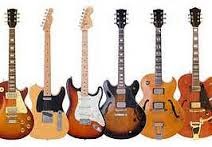
Legendary player of the Electric Guitar includes Jimi Hendrix (the blues and rock) and Chuck Berry (father of rock and roll music). Notable guitarists include B.B.King, Slash, Eric Clapton, Keith Richards (blues) and Jimmy Page of Led Zeppelin group and Les Paul, a talented guitarist of the 1950 period who pioneered the design of the modern Electric Guitar. Popular rock group Beatles had its members John Lennon, George Harrison and Paul McCartney as eminent guitarists.
For any beginner to learn the Electric Guitar, there are teachers and established players for guidance. Manhattan School of Music and San Francisco Conservatory of Music in the USA are well known schools of music. Some beginners may learn to play in 8 weeks, six months, a year or more than a year to become an expert guitarist. The steps involved in learning an Electric Guitar are:
- Firstly, get a guitar of your choice along with the accessories.
- Learn some easy tunes from a reference such as a book. Popular and exciting tunes help in holding the interest.
- Expand the basics of playing with some difficult tunes.
- Pick up some new techniques and master them such as finger tapping to the tunes, which helps in playing on the guitar.
- Play solo first, then join or make a band and go on playing.


